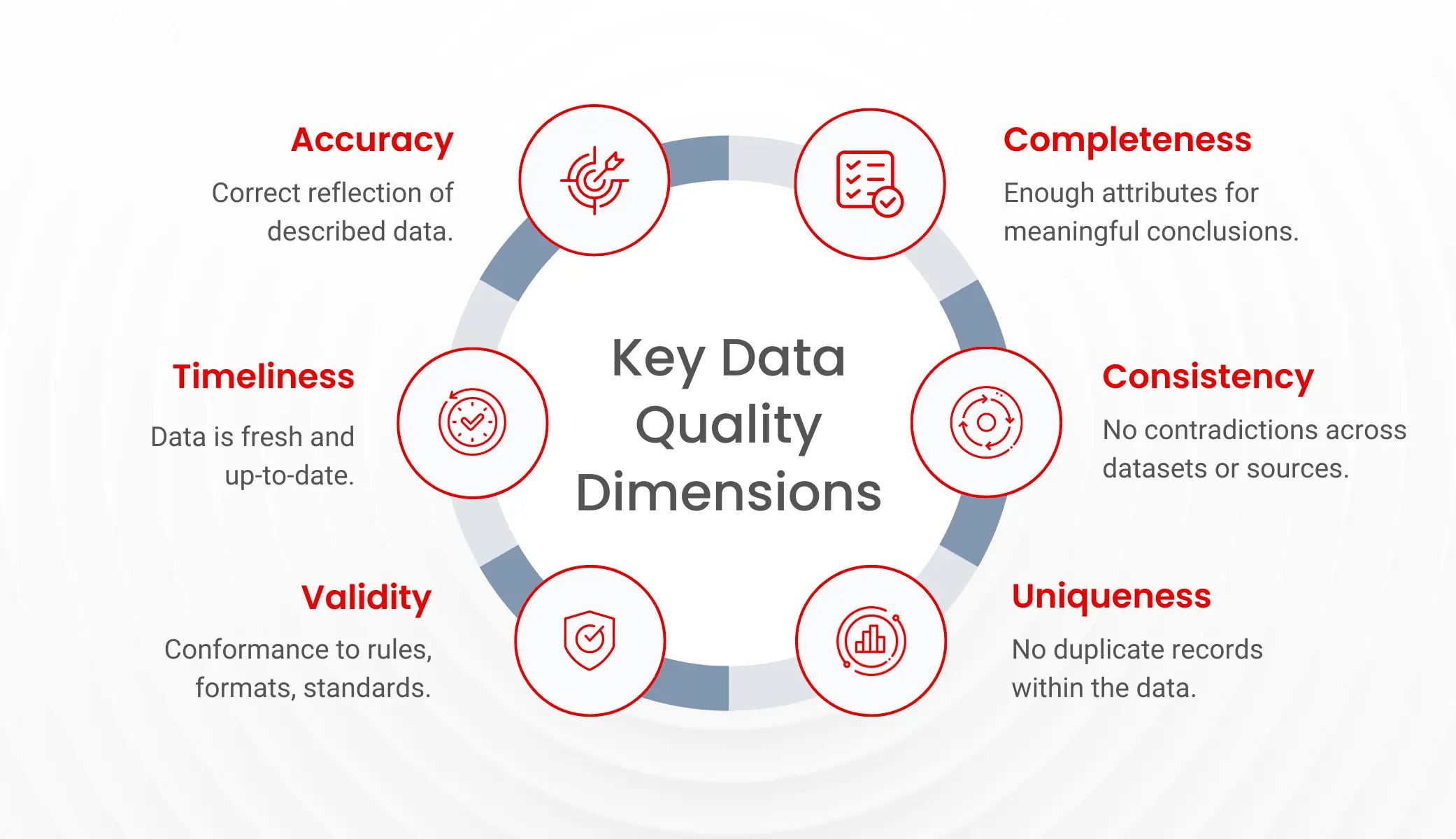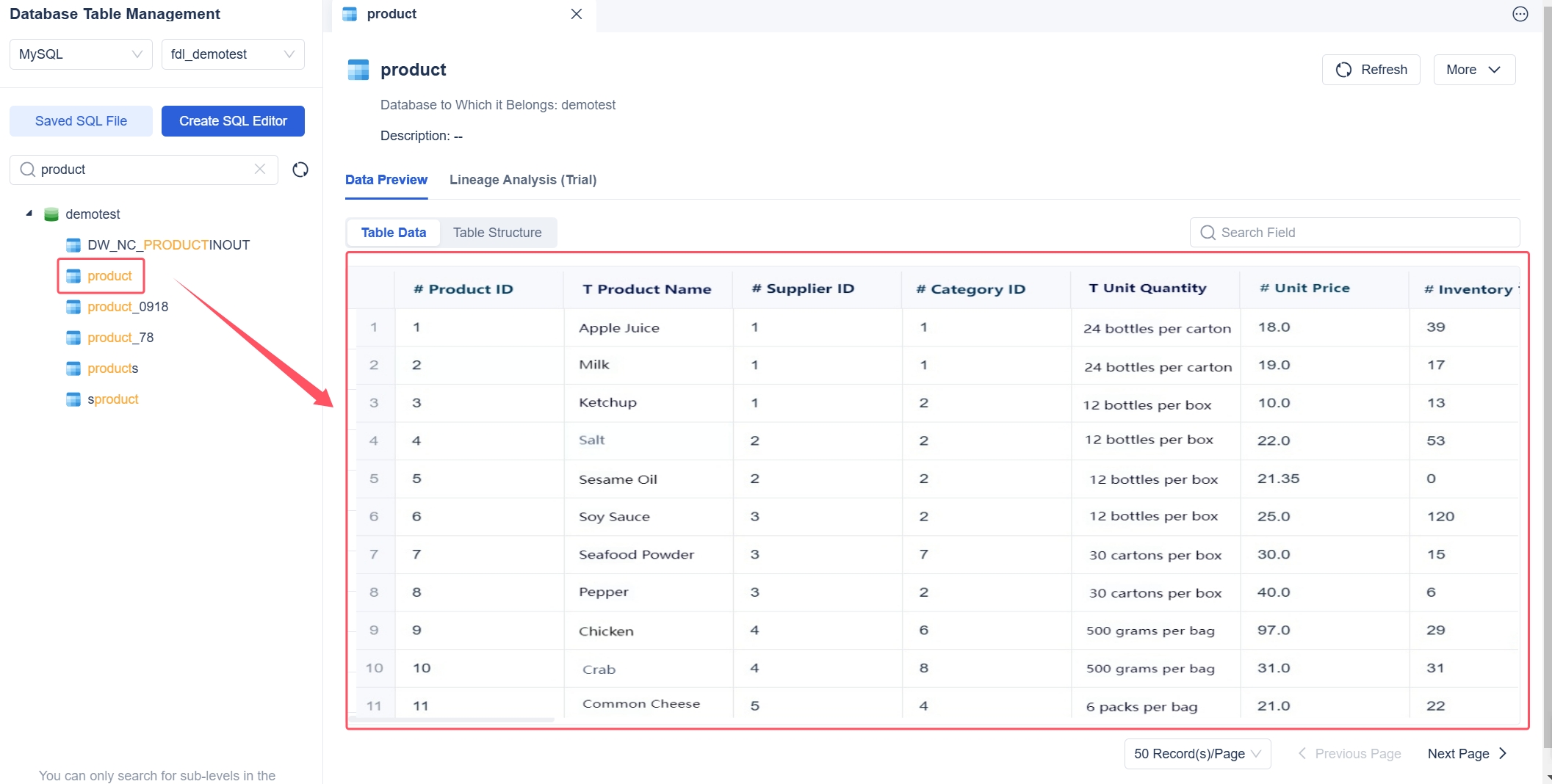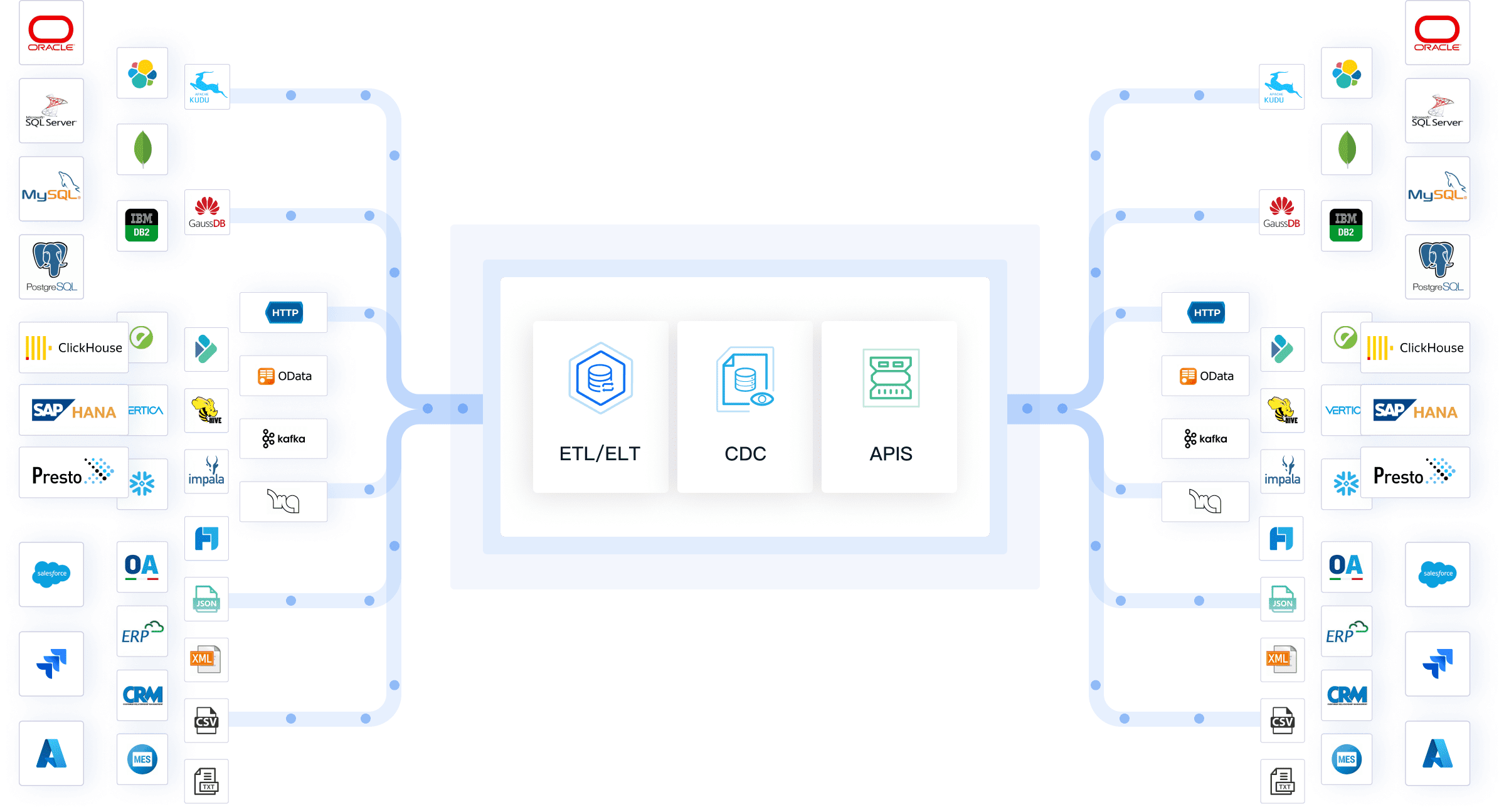Data quality management means you control and improve the accuracy, consistency, and reliability of your data. You need this because data drives your business outcomes. If you rely on poor data, your reports and analytics may mislead you, which can hurt your business decisions and reduce efficiency. In fact, 64% of organizations say poor data quality is their top challenge and it negatively impacts results. You can use platforms like FineDataLink to help manage and integrate your data, which supports the importance of data quality in every part of your organization.
Data Quality Management

What it means
You need data quality management to ensure your business data remains accurate, complete, and reliable. This process involves several core components that help you maintain high standards for your data. You start by profiling your data. This step helps you understand the structure and content, so you can spot inconsistencies and anomalies. You then cleanse your data by removing errors, duplicates, and missing values. Enrichment adds valuable information from trusted sources, making your data more useful. Validation sets rules and standards for your data, ensuring it meets the requirements for business intelligence and analytics. Monitoring and reporting allow you to track key metrics and address issues before they affect your operations.
Here is a table that summarizes the core components of data quality management:
| Core Component | Description |
|---|---|
| Data Profiling | Analyze structure, content, and relationships to find anomalies and inconsistencies. |
| Data Cleansing | Remove errors, duplicates, and missing values to improve data quality. |
| Data Enrichment | Add supplementary information from trusted sources to increase completeness and value. |
| Data Validation | Set rules and standards for data to ensure it meets business intelligence and analytics requirements. |
| Monitoring and Reporting | Track metrics and KPIs to maintain data quality and address issues proactively. |
Industry standards define data quality management by focusing on several dimensions. You measure accuracy to check if your data matches real-world conditions. Completeness ensures all necessary data is present. Consistency checks if your data remains the same across different systems. Timeliness makes sure your data is up-to-date and available when needed. Uniqueness prevents duplication and redundancy.

Why it matters
You rely on data quality management to drive better business outcomes. High-quality data supports your decision-making and improves operational efficiency. When you manage data quality well, you avoid costly mistakes and reduce risks. Poor data quality can cost your organization millions each year. You may lose up to $15 million annually due to errors, downtime, and slow resolution of issues. Human error alone can cost between $150,000 and $600,000 each year. Data downtime incidents have nearly doubled, and the time needed to fix data quality problems has increased by 166%.
You face several business problems when you ignore data quality management:
- You undermine digital initiatives and lose your competitive edge.
- Customer trust declines when you deliver inaccurate or incomplete information.
- Operational costs rise due to inefficiencies and errors.
On the other hand, strong data quality management gives you a clear advantage. Walmart uses reliable point-of-sale data to optimize inventory, reducing waste by 30% and increasing profit margins by 15%. Netflix analyzes viewer behavior data to make strategic decisions, achieving a 93% retention rate and saving $1 billion annually. Amazon listens to customer feedback to improve products, showing how high-quality data leads to innovation and customer satisfaction.
You can follow these steps to improve your data quality management:
- Define the scope and boundaries for your data quality efforts, focusing on critical data elements.
- Document standards for each data quality dimension.
- Establish criteria to measure accuracy, completeness, consistency, timeliness, and uniqueness.
- Involve key stakeholders in reviewing and approving your standards.
You can use pre-defined templates and established frameworks like DMBOK or ISO 8000 to guide your process. Data quality management tools with built-in templates and automated workflows help you streamline your efforts.

Data Quality Management Framework

Key elements
You need a strong data quality management framework to maintain high standards for your data. This framework gives you a structured approach to control, monitor, and improve data quality across your organization. You can break down the key elements of a data quality management framework into several important areas.
- Validation processes help you check data accuracy and compliance with rules. You perform regular checks to ensure your data meets business requirements.
- Data cleansing methods allow you to identify and correct errors. You use tools to remove duplicates and fix inconsistencies, which improves overall data quality.
- Routine audits let you evaluate data sources periodically. You verify that your data follows quality standards and spot areas for improvement.
- Measurement metrics give you a way to monitor data quality over time. You define metrics such as accuracy, completeness, and timeliness to track progress.
You also need to focus on core data quality characteristics. These characteristics include accuracy, completeness, timeliness, and traceability. You measure each characteristic to ensure your data supports business intelligence and analytics.
Here is a table that summarizes the essential data quality characteristics you should monitor in your framework:
| Data Quality Characteristic | Description |
|---|---|
| Accuracy | Data matches real-world values |
| Completeness | All necessary data is present |
| Timeliness | Data is up-to-date and available |
| Lineage and Traceability | You can track data origins and changes |
A robust data quality management framework also includes these components:
- Data governance policy
- Data catalog for organizing information
- Quality metrics and standards
- Data stewards and owners who maintain data quality
- Quality control tools and systems
- Monitoring and alerting mechanisms
- Training programs for staff
- Compliance guidelines for regulations
- Documentation and record-keeping
- KPIs and success metrics
You assign data stewards and owners to specific data sets. They take responsibility for maintaining quality, security, and usage. This creates accountability and ensures someone always monitors each segment of data.
Quality metrics and standards help you quantify data quality. You use these benchmarks to assess your current state and identify areas for improvement. You measure effectiveness by tracking metrics such as accuracy, completeness, consistency, timeliness, validity, and uniqueness. You also use automated tools and dashboards for real-time monitoring.
Regulatory requirements play a major role in shaping your data quality management framework. Industries like healthcare and financial services require strict compliance with data protection and privacy laws. Your framework must ensure confidentiality, integrity, and availability of sensitive data.
Best practices
You can follow best practices to maintain high data quality across your enterprise. These practices help you build a reliable data quality management framework and keep your data fit for business use.
| Best Practice | Description |
|---|---|
| Centralized Governance | You create data policies, standards, defined roles, and a business glossary to streamline management. |
| Regular Training | You educate employees through seminars and hands-on sessions to improve data quality knowledge. |
| Data Audits | You conduct audits to find and fix inaccuracies and inconsistencies. |
| Data Validation Rules | You set rules to verify data correctness during entry, ensuring reliability. |
| User Empowerment | You encourage users to identify and resolve data quality issues, building a proactive culture. |
You can use these steps to strengthen your data quality management framework:
- Establish a structured governance framework with clear roles and responsibilities.
- Conduct regular audits to ensure compliance with quality standards.
- Implement validation rules to check data accuracy at entry points.
You should also empower users to take initiative in resolving data quality issues. You provide training programs to help staff understand data quality management and its impact on business outcomes.
You measure the effectiveness of your data quality management framework by defining and tracking data quality metrics. You monitor these metrics regularly to identify areas for improvement. You use both quantitative and qualitative assessments, including stakeholder feedback and ROI analysis.
You need to comply with regulatory requirements in your industry. Healthcare, banking, and manufacturing organizations must follow strict laws and standards. Your framework should address these needs and ensure your data remains secure and reliable.
Tip: You can use automated tools and dashboards to monitor data quality metrics in real time. This helps you respond quickly to issues and maintain high standards.
FineDataLink: A modern solution for data integration and quality management
After you set up your data quality management framework, you need the right technology to support it. FineDataLink gives you a modern solution for data integration and quality management. You can use its core features to build a high-quality data layer for business intelligence.
FineDataLink offers real-time synchronization, advanced ETL/ELT capabilities, and easy API integration. You can synchronize data across multiple tables with minimal latency. You use ETL/ELT tools for data preprocessing and warehouse construction. You launch API interfaces quickly without writing code, which makes sharing data between systems simple.
FineDataLink supports over 100 common data sources. You can integrate and synchronize data from different platforms, reducing silos and improving connectivity. The platform provides a visual interface with drag-and-drop functionality, making deployment and operation user-friendly.
You benefit from features such as error queue management, automatic synchronization of source table structures, and multiple synchronization methods. These features help you maintain data consistency and reliability across your organization.
You use FineDataLink to automate data integration workflows, reduce manual effort, and improve scalability. The platform helps you build a robust data quality management framework that supports business intelligence, analytics, and regulatory compliance.

Data Quality Management in Business
Risks of poor data
You face significant risks when you neglect data quality management in your business. Poor data quality can lead to compliance violations, financial loss, and damage to your reputation. Inaccurate or incomplete data exposes you to legal repercussions and hefty fines. For example, privacy regulation penalties can reach up to 4% of your global annual turnover or €20 million. Errors in master data may cause mistakes in tax filings, resulting in missed deadlines and penalties.
| Evidence Description | Risk Type |
|---|---|
| Poor data quality can lead to breaches of standards, resulting in legal repercussions and fines. | Compliance Violations |
| Inaccurate or mishandled data can expose businesses to compliance violations, attracting hefty fines and damaging reputation. | Compliance Violations |
| Privacy regulation penalties can be substantial, up to 4% of global annual turnover or €20M/£17.5M. | Financial Loss |
| Inaccurate master data causes errors in VAT filings, leading to missed deadlines and penalties. | Financial Loss |
In manufacturing, poor data quality management increases operational costs and wastes resources. You may see delays in order fulfillment and harm to your brand reputation. Inaccurate data undermines the reliability of analytics, making it difficult to make informed decisions. Regulatory compliance becomes harder to achieve, which can result in further penalties. You also risk impeding digital transformation efforts, which are essential for staying competitive.
Benefits of good data
When you invest in data quality management, you unlock many benefits for your business. Good data quality improves decision-making and increases operational efficiency. You can enhance customer satisfaction and achieve regulatory compliance. Organizations that focus on data quality management report better revenue and profitability, increased data security, and a stronger competitive advantage.
- Improved decision-making
- Increased operational efficiency
- Enhanced customer satisfaction
- Regulatory compliance
- Better revenue and profitability
- Increased data security
- Competitive advantage
- Scalability and future-readiness
You also see measurable cost savings. For example, insurance companies have reported annual savings of $1.93 million after modernizing their ETL processes. Healthcare organizations have reduced development time by up to 75%, achieving positive ROI within months. Data quality management prevents mistakes, reduces repetitive tasks, and lowers labor costs.
In manufacturing, you can use solutions like FineReport to monitor product quality in real time. FineReport enables you to analyze trends in defect rates and scrap rates, helping you identify root causes quickly. With real-time dashboards and visualizations, you maintain high standards and improve production efficiency. Good data quality ensures the reliability of your analytics, supports compliance, and protects your brand reputation.
Note: By prioritizing data quality management, you build a foundation for reliable analytics, efficient operations, and long-term business success.

Implementing Data Quality Management
Steps to get started
You need a clear plan to begin your data quality management journey. Start by assessing your current data quality levels. Inventory your data use cases and categorize them as analytical, operational, or customer-facing. This helps you understand where your data quality stands. Next, rally your organization. Align stakeholders by discussing their pain points and the risks of poor data quality. Building support for data quality management ensures everyone understands its value.
Follow these steps to launch your data quality management initiative:
- Baseline current data quality levels by reviewing all data use cases.
- Align your organization by engaging stakeholders and addressing concerns.
- Set up data governance policies to guide your data quality management efforts.
- Define key performance indicators (KPIs) to track progress, such as reduction in data entry errors and improved customer retention rates.
- Train your team to recognize and resolve data quality issues.
You should monitor KPIs like overdue audits, complaint rates, cost of quality, and policy acknowledgments. These metrics help you measure the impact of your data quality management program.
Overcoming challenges
You will face several challenges when implementing data quality management. Common issues include lack of necessary metadata, difficulty recruiting data engineers, human error, duplicate and inconsistent data, incomplete or inaccurate data, outdated information, and data integrity problems. Poor data quality can lead to missed opportunities and compromised business performance.
| Challenge | Solution |
|---|---|
| Lack of necessary (meta)data | Implement robust data governance policies |
| Difficulty recruiting data engineers | Invest in data quality tools and technologies |
| Human error | Foster a culture of data quality |
| Duplicate data | Implement robust data governance policies |
| Inconsistent data | Invest in data quality tools and technologies |
| Incomplete data | Foster a culture of data quality |
| Inaccurate data | Invest in data quality tools and technologies |
| Outdated data | Implement robust data governance policies |
| Data integrity issues | Foster a culture of data quality |
| Poor data quality | Invest in data quality tools and technologies |
| Missed opportunities | Foster a culture of data quality |
| Compromised business performance | Implement robust data governance policies |
You can overcome these challenges by establishing strong data governance, investing in data quality management tools, and fostering a data-driven culture. Senior leadership support is essential. When executives sponsor data quality management, you gain momentum and commitment across your organization.
Senior level sponsorship is fundamental to implementing change. Aligning the Executive Team addresses the issue of senior management ownership and provides senior leaders with the capability to transform a company’s performance and shift their whole mindset.
You should also communicate the purpose and benefits of data quality management clearly. Provide training and resources, and listen to stakeholder concerns. Collaboration between teams helps you build a culture focused on data quality.
FineDataLink offers efficient data integration and automation for your data quality management needs. Its low-code platform and real-time capabilities simplify complex data flows and support robust data governance. You can automate data quality checks, synchronize data instantly, and reduce manual errors. FineDataLink helps you build a reliable foundation for data quality management and business intelligence.

You can see that data quality management shapes your business success. Reliable data helps you make better decisions, improve efficiency, and build customer trust. Poor data quality leads to lost revenue, wasted time, and compliance risks. The table below highlights how strong data practices drive positive outcomes:
| Benefit | Risk of Poor Data |
|---|---|
| Improved decision-making | Bad decisions |
| Enhanced customer satisfaction | Damaged reputation |
| Increased efficiency | Decreased productivity |
Prioritize data quality and explore solutions like FineDataLink to support your growth and innovation.

Continue Reading About Data Quality Management
Enterprise Data Integration: A Comprehensive Guide
What is enterprise data and why does it matter for organizations
Understanding Enterprise Data Centers in 2025
Enterprise Data Analytics Explained for Modern Businesses
FAQ

The Author
Howard
Engineer Data Management & Ahli Data Research Di FanRuan
Related Articles

Top 10 Database Management Tools for 2025
See the top 10 database management tools for 2025, comparing features, security, and scalability to help you choose the right solution for your business.
Howard
Dec 17, 2025

Best Data Lake Vendors For Enterprise Needs
Compare top data lake vendors for enterprise needs. See which platforms offer the best scalability, integration, and security for your business.
Howard
Dec 07, 2025

Top Data Ingestion Platform Compared
Compare the top 7 data ingestion platforms, including real-time features, integration, scalability, and pricing to find the best fit for your business.
Howard
Dec 04, 2025



